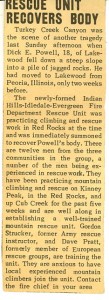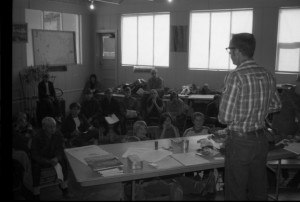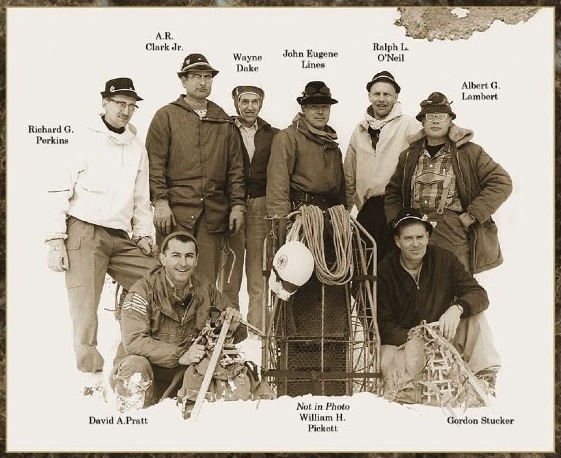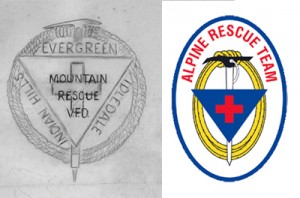History of Alpine Rescue Team
 The start of what has become the Alpine Rescue Team, like many other organizations, grew from a specific event. On June 27, 1959 a climbing accident occurred in Turkey Creek Canyon involving four climbers at Lovers Leap, a 400-foot tall crag. After successfully completing the climb the group started a series of rappels. On the second rappel while the second climber descended, a single piton used as the anchor worked loose resulting in the rope dropping to the ground and the climber plunging to his death. Since the climbing team only had one rope, the other two climbers had to be rescued. The rescue of these two individuals and the recovery of the one deceased climber involved the combined efforts of the Idledale, Evergreen and Indian Hills Fire Departments along with some recreational climbers. Because of this incident, the surrounding community fire departments and ambulance personnel were forced to recognize that they were ill trained and not equipped to perform high angle rock rescues and evacuations in the Clear Creek, Bear Creek and Turkey Creek canyons.
The start of what has become the Alpine Rescue Team, like many other organizations, grew from a specific event. On June 27, 1959 a climbing accident occurred in Turkey Creek Canyon involving four climbers at Lovers Leap, a 400-foot tall crag. After successfully completing the climb the group started a series of rappels. On the second rappel while the second climber descended, a single piton used as the anchor worked loose resulting in the rope dropping to the ground and the climber plunging to his death. Since the climbing team only had one rope, the other two climbers had to be rescued. The rescue of these two individuals and the recovery of the one deceased climber involved the combined efforts of the Idledale, Evergreen and Indian Hills Fire Departments along with some recreational climbers. Because of this incident, the surrounding community fire departments and ambulance personnel were forced to recognize that they were ill trained and not equipped to perform high angle rock rescues and evacuations in the Clear Creek, Bear Creek and Turkey Creek canyons.
Dick Perkins, then Fire Chief of Indian Hills found the dislodged and bent piton. Today it is displayed at the Team’s headquarters where it serves as a reminder about the seriousness and importance of the Team’s efforts. This reminder is represented by an annual award – The Bent Piton – given to a member or members for outstanding performance while participating on a Mission or Missions.
This mission, the increased local need for a technical mountain rescue capability and the active encouragement of the Rocky Mountain Rescue Group in Boulder were all essential factors in the formation of the Alpine Rescue Team. In its formative stages, before incorporation, the Team was sponsored by the volunteer fire departments of Evergreen,Indian Hills and Idledale. After all three departments requested volunteers to join this special rescue unit; the first ever meeting was held in the summer of 1959 with six members in attendance, two members from each of the three mountain fire departments.
Early on, the team realized that they had to learn to climb and protect each other before they could even consider helping anyone else. It was not until “Rozzie” Clark Jr., then the Fire Chief of the Evergreen Fire Department, convinced Gordon Stucker and Dave Pratt to get involved, did the team find leaders to train the team in Mountain Rescue. Gordon had provided mountaineering training for soldiers at Fort Carson, and Dave was a former member of a European rescue team. Excited by the opportunity Gordon and Dave stuck around and ultimately took over the team’s training. As stated by Charter member, Gene Lines, “Rozzie Clark Jr. kept us alive financially and Gordon and Dave kept us alive physically.”
The newly-founded Team didn’t have to wait long before their first mission. On September 20, 1959 the Team was called to Turkey Creek Canyon.
As the team’s mountain search and rescue expertise increased, it was time to separate from the Fire Districts and become an independent organization. In February of 1960, the nine Charter Members listed below, wrote the original Team By-laws. Two months later on April 20th, 1960 the organization was incorporated with the name, Alpine Rescue Team. The principal office of the corporation was located in Kittredge. Seven of the nine charter members served as the first Board of Directors.
Alpine Rescue Team’s nine Charter Members as listed on the original Article of Incorporation include:
- David A. Pratt, Board Member
- A.R. Clark Jr., Board Member
- Albert G. Lambert, Board Member
- William H. Pickett
- Richard G Perkins, Board Member
- Ralph L. O’Neal, Board Member
- John Eugene Lines, Board Member
- Wayne Dake
- Gordon Stucker, Board Member
Albert “Al” Lambert served as the Team’s first President and Gordon Stucker served as the Team’s first Team Captain (Field Director).
On August 1, 1960 members of the Alpine Rescue Team became part of Colorado’s mountaineering history with their support of the first ever ascent of the Diamond on Long’s Peak. In the summer of 1960, National Park Service guidelines for big wall climbs where changed to allow climbers to make these technical climbs provided that they could demonstrate that they were competent climbers and could also provide their own support team that would perform a rescue if necessary. California climbers Dave Rearick and Bob Kamps made the first ever ascent of the 900-foot tall Diamond. Members of the Alpine Rescue Team served as their support team.
As the Team’s proficiency increased, members’ interests extended beyond the Inter-canyon area. In 1963 Team members became active in the creation of the Colorado Rescue Association, incorporated as the Colorado Search and Rescue Board in 1970. In 2019 the organization changed the name to the “Colorado Search and Rescue Association”. The Team would no longer think in terms of geographical limits. Since 1960, the Alpine Rescue Team has operated throughout the Rocky Mountain region and across the U.S.
Two years later, in 1962, the team became the second Colorado Mountain Rescue Team to be a fully accredited member of the Mountain Rescue Association. Only six of the original nine charter members were still members of the team at this time. Below are the eighteen members of the Team as submitted on the May 29, 1962 application to the MRA.
| Rescue Members | Support Members | |
| John Biewener (President) | Art Julian | |
| Rossie Clark, Jr (Coordinator) | Butch Clark | |
| Cal Estap | Ed Haynes | |
| Lou Jansen (Secretary) | Kirk Brown | |
| Al Lambert | Jim Tiernay | |
| Gene Lines | ||
| Dick Perkins | Team Doctor | |
| Bill Sims (Rescue Team Captain) | Robert Collier MD | |
| Gordon Stucker | ||
| Fred Coyle | ||
| Don McNair | ||
| Dave Pratt |
In 1963, Alpine adopted the following Articles of Amendment to its Articles of Incorporation. The original six objectives stated in 1960 were revised to the five team objectives listed below. These five objectives were rewritten in 1975 and again in 2002. As part of our current By-laws, the objectives guide the team.
- To maintain a ready capability to carry out humanitarian search, rescue and recovery operations in mountainous terrain, under all climatic conditions, and in any other situation compatible with Team capabilities.
- To encourage and actively assist Team members in acquiring mountaineering and mountain rescue skills, knowledge and experience.
- To teach individuals and groups safe mountaineering practices and safety in the mountains.
- To cooperate with other mountain search and rescue organizations and with other rescue disciplines through formal association, compacts and mutual agreements at the local, regional, national and international levels.
- To maintain and foster the independent character of the mountain rescue discipline through formal association with other mountain rescue groups and to encourage and assist groups that make a similar commitment.
In 1965, the initial “Standards of Proficiency” were written by Al Lambert and Gordon Stucker. These were then rewritten in 1975 and 1994 and amended a number of times from 2000 to 2010 before they were completely rewritten in 2017 as what we now refer to as, the “Guidelines of Proficiency.”
High standards, quality training, and serious search and rescue operations improved the Team’s prowess. That reputation, combined with Gordon and Joann Stucker’s personal friendship with Roy and Alice Holubar along with Charter Member, Gene Lines working for the Holubars, allowed the Alpine Rescue Team to acquire specially designed mountaineering equipment. Alice Holubar designed and made mountaineering clothing, packs and sleeping bags in her basement home in Boulder. Holubar became the first American Mountaineering mail order supply house. Alice Holubar was to the mountaineering equipment business what the 10th mountain Division was to the American ski industry. If Alice could not sew it, she worked with the American Red Cross to locate and procure special equipment for the Team including surplus climbing equipment, stokes litters and medical supplies. Alice’s original designs are still copied today by the outdoor industry. Her designs have not only stood the test of time, but her products have also withstood time. The Team is proud to have many of the original custom made sleeping bags and down suits that were designed and made for members by Alice Holubar.
 In 1963 the Team sponsored an Explorer Scout Program. That first year, twelve young men participated in the Evergreen “Explorers Post 95”. The Explorer Program continued for a number of years before it dissolved. In the late 1960’s, Team member, Lindon “Woody” Wood began a new training program for young men and women ages 13 and older. At the time these teenagers performed their work in the same amounts and at the same level of quality expected of every adult member. These young men and women conducted trainings and lead searches and rescues. Unfortunately, as Evergreen transitioned from a rural to a suburban community, societal norms pressed the Team to raise their minimum age. In the early 80’s the age requirement was raised to 16. It was not until the late 80’s that the Team adopted the current age requirement of 18 for all Team members.
In 1963 the Team sponsored an Explorer Scout Program. That first year, twelve young men participated in the Evergreen “Explorers Post 95”. The Explorer Program continued for a number of years before it dissolved. In the late 1960’s, Team member, Lindon “Woody” Wood began a new training program for young men and women ages 13 and older. At the time these teenagers performed their work in the same amounts and at the same level of quality expected of every adult member. These young men and women conducted trainings and lead searches and rescues. Unfortunately, as Evergreen transitioned from a rural to a suburban community, societal norms pressed the Team to raise their minimum age. In the early 80’s the age requirement was raised to 16. It was not until the late 80’s that the Team adopted the current age requirement of 18 for all Team members.
In 1973 Sue Paul and Edith Head became the first two women to join Alpine. Sue Paul also served as the first women President of Alpine in 1981.
ART Emblem
The team emblem, designed by Dave Pratt, refers to the original association of the three local fire departments. Each side of the blue triangle represents one of the aforementioned communities. The Red Cross symbolized the commitment to aid those in need of our services and the significant assistance of the Jefferson County Chapter of the American Red Cross. The climbing rope and ice axe refer to the specialty in which we were to engage and to the environment – the mountain.
The Alpine Rescue Team name was chosen to convey the nature of their work and how the organization goes about it. Alpine signifies the environment. Rescue indicates the purpose. Team reminds members that the organization is not a social club, or some loose affiliation of people vaguely interested in mountain search and rescue.
More than 60 years later, the Alpine Rescue Team continues to respond to wilderness emergencies providing specialized mountain search and rescue, day and night, 24-7, and never charges for its services. To meet its mission of saving lives through rescue and mountain-safety education the Team relies upon its dedicated volunteer members and the generous contributions of the local communities.

